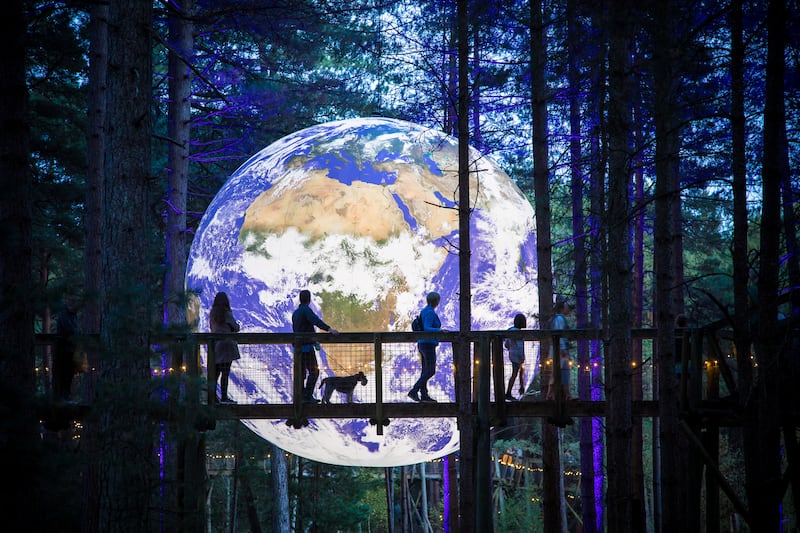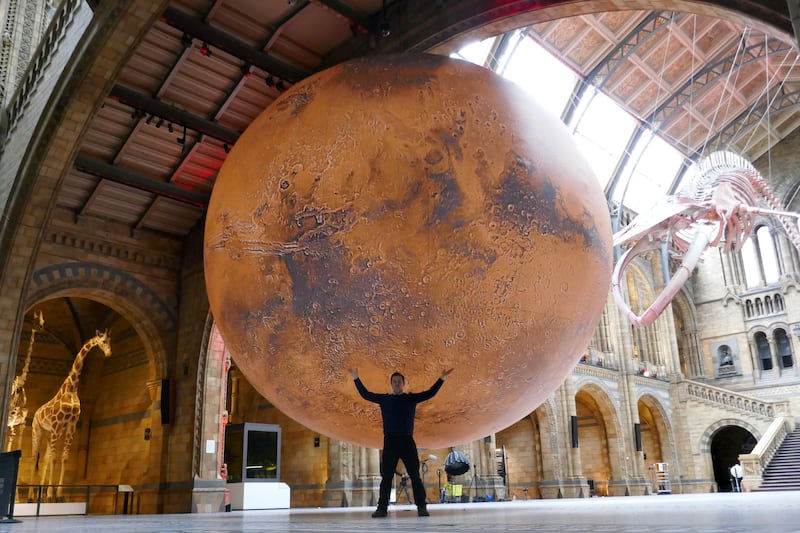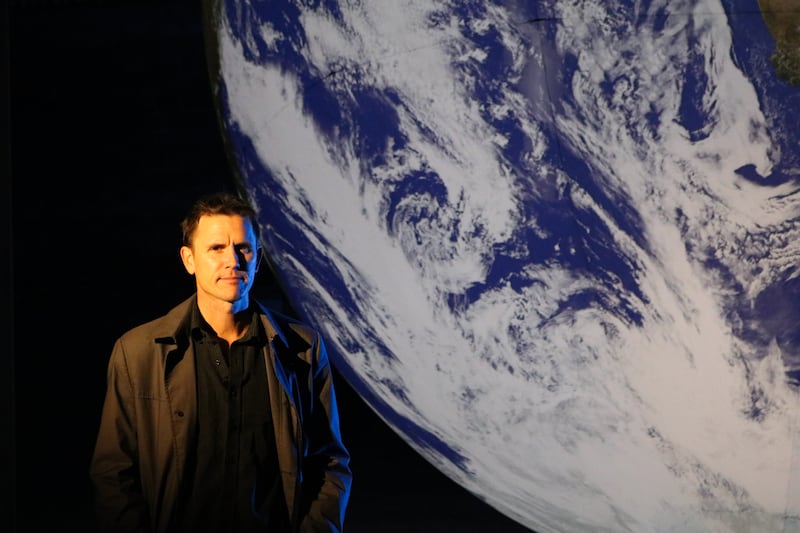When astronauts first went into space, they were focused on the moon, but seeing Earth from above turned out to be profound. Dubbed “the overview effect”, the shift in perspective gives rise to protective feelings. Cosmonaut Yuri Gagarin, the first human to enter space, recalled: “I saw how beautiful our planet is. People, let us preserve and increase this beauty, not destroy it.” It was the same for Apollo 11 pilot, Michael Collins: “I had a feeling it’s tiny, it’s shiny, it’s beautiful, it’s home, and it’s fragile.”
Right now, you could be forgiven for thinking that everyone needs to get up above the atmosphere and take a good look down. That said, I’m not sure the vision of Earth from above has inspired caring notions in the likes of Jeff Bezos and Richard Branson. Still, failing being a billionaire with galactic aspirations, you could always go to Cork, where Luke Jerram’s Gaia, a 7m sculpture of Earth is being installed for the Midsummer Festival.
Named for the ancient Greek personification of Earth, the sculpture shows a replica created with imagery (including clouds) provided by Nasa. Jerram is a dab hand at astral bodies and his Mars will also be arriving on this island, appearing in Galway in July. It’s a nice conjunction as, in some quarters, Mars is the next target for despoiling, when we’re done messing up our home planet.
Like Olafur Eliasson, Anish Kapoor and the late Christo and Jeanne-Claude, Jerram is an artist who makes works to a scale that could end up being simply spectacle – but fortunately don’t. Nonetheless, you’re frequently waiting for the onslaught of selfie-takers to abate before you can get a quiet moment to see how you feel about them. Jerram, who has been described as “probably the most famous artist you’ve never heard of” didn’t grow up with an arty background – except inasmuch as his mother would leave out coloured pencils and paper, to amuse him if he woke up early.
READ MORE

His father was a milkman and his mother a teacher. “I was born and raised in a little village in Stroud, north of Bristol. I remember seeing my first exhibition. It was in Tate Liverpool.” Offered a choice on a school trip, between seeing Liverpool play football or going to an exhibition, the then teenager chose art. “I went to the gallery. I was about 17, seeing a Giacometti exhibition. Giacometti sculptures are quite something,” he continues, smiling but serious. “From the side they’re ordinary, and then you walk around and you realise they’re only that narrow,” he holds up pinched fingers. “I thought there was something really interesting about the optical illusion of it all. Still,” he pauses, “It’s a shame I missed out on going to the football…”
I wonder if Jerram minds the selfie brigade, getting in the way of potentially profound arty encounters. “People want to document a moment,” he says. We are connecting via Zoom, although I don’t get to see the usual chaos and productive clutter of an artist’s workspace. Instead, he is in a clean white office, an photograph of Gaia, installed over water, on the wall behind. He is similarly guarded himself, tactful and measured, and very charming in that self-deprecating way that can be quintessentially English. But I get the sense he would never give away anything unintended.
“They’ll come in and take a load of photos,” he says. “But then they’ll sit and contemplate and watch other people, and talk to one another about what they’re seeing.” He’s right. I tend to do the same. It’s easy to get holier-than-thou about the selfie mob, but when I look through my own photos, there are more than enough of me standing in front of things. Size seems to have an effect. If it’s a small artwork, I’ll have an image of it. If it’s enormous, there will most likely be one of me with it. Perhaps that’s one of the ways we comprehend enormity. If that’s the case, Jerram is on to something with his scaled-down planets. Jerram agrees. “These artworks, they leave space for the public to look at themselves in relation to it, so the public are almost part of the artwork, they’re part of the ingredients of the experience.”

Another ingredient is context. Four years ago, I was disappointed by Jerram’s Museum of the Moon in Galway. After a giddy opening night, when it hung, like a heavenly visitation, out in the elements on Shop Street, it went on to lurk in a corner of the Human Biology Building at NUI Galway, like a small planetary child in the naughty corner. It wasn’t anyone’s fault. It’s a risk all festivals take when programming large-scale experimental works. “There’s a bit of that,” Jerram agrees, sanguinely. “It’s hard to control some of the elements. Things like turning off street lamps, crazy weather.” He recalls another location where the Moon was struck by lightning. A version that went to the United States came back riddled with holes. Someone had tried to shoot the Moon.
Expect greater things this time round, as Galway International Arts Festival will be showing Mars in the atmospheric yard at Persse’s Distillery on Nun’s Island, while Gaia will be at St Colman’s Cathedral, Cobh. Each will be accompanied by specially commissioned soundscapes. Artists differ in how they hope, or expect their works to be received in public. Some can be quite didactic about meaning and interpretation. Others, at the opposite end, claim that once they have sent a piece out into the world, what happens next is entirely in the hands, and minds of the audience.
How much of an agenda does Jerram have for how his works are seen and understood? Mars was co-commissioned by the UK Space Agency, so there’s an obvious element of inspiring scientific imaginations. “There needs to be an open interpretation to a certain degree,” he says, considering. “The difficulty I have is when someone wants to communicate an agenda I’m not keen on.” He describes an installation of Museum of the Moon in Bath Abbey, where an interpretation panel was, as he puts it, “all full of falsehoods and inaccuracy”, and focused the installation on God and religion. He had the panel taken down.
One reason Jerram’s name is not as famous as the works he makes, is that his output is very eclectic. Drawn together by his wide-ranging interests in perception arising from his own experiences of being colour-blind: in the science and physics of the world, which includes everything from the environment, to the science of sleep, to virology; and in what happens when people are brought together by art; it’s hard to pin down what a Luke Jerram work looks like. Often, it’s an idea that’s so good, you wonder why no one had done it before. The street pianos that now pop up at festivals, train stations and town squares? The idea was originally his, from Play Me, I’m Yours, touring internationally since 2008.

Then there was the Sky Orchestra, in which musicians played in an ultra Covid-safe way, in hot-air balloons, gliding overhead. Sky Orchestra had originated as a project in 2011 to explore how sounds affect sleep, predating Max Richter’s epic Sleep score by four years. So you might say they’re prescient and large-scale, and yet he made an engagement ring that has the sound of the proposal etched on to it, which can be played via a miniature record player. He also made, on commission, a glass replica coronavirus, just months before the pandemic hit. “That was a bit nuts,” he says. “I realised the significance of it, and invited the press to come and take pictures. I thought it would be useful for them to communicate what these things actually look like.” Editions were sold, raising money for Médecins Sans Frontières.
Maybe the connection is that Jerram, like so many of us, has a mind that dreams up ideas, and yet he differs, in that he then goes about making them a reality. He also puts his ideas into the realm of art, which is another way of saying he likes them to be open-ended, explored for their ideas as well as being received as objects. He talks enthusiastically about the idea of “unexpected outcomes”. Some artworks, like the engagement ring for his fiancée, now wife, are personal projects. Others are the results of approaches, such as from the Space Agency. He is currently working with the English National Opera, and is just back from Uganda, where he has been working on a fashion project to help spread the word about immunisation.
“I put proposals and documents together, often coming up with 10 ideas at once. And then they’ll say ‘We’ll have that one, because this one is rubbish…’ And then I’ll end up with all these ideas of projects that I’m waiting to deliver.” Ideas come to him visually, rather than in words, and he mocks them up into photographs. He holds a fan of them up to the Zoom camera, and I’m smitten by the huge potential for wonder and the leaps of imagination he is clutching. He singles one out. “There’s a project called the Sky Walk. I like the idea of rope bridges across rooftops, a kilometre of rope bridges to open up and revel all the hidden architecture of a city.”
Someone, somewhere, please commission it.
Luke Jerram’s Gaia is at St Colman’s Cathedral, Cobh, from June 15th-26th, as part of the Cork Midsummer Festival. Mars will be at Persse’s Distillery Yard, Nun’s Island, Galway, from July 14th-17th as part of the Galway International Arts Festival. Admission to both is free. corkmidsummer.com, giaf.ie, lukejerram.com















